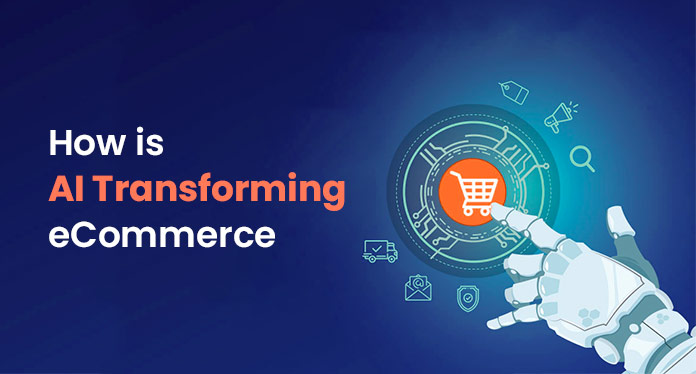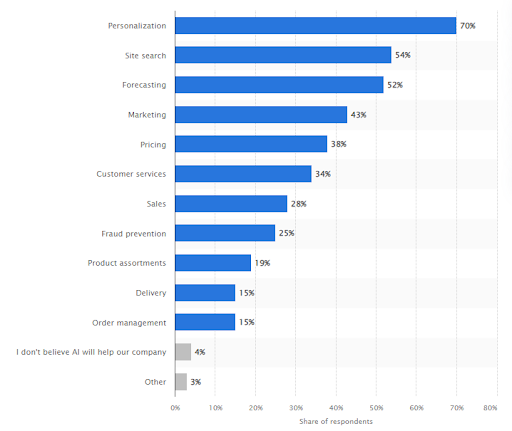How is AI Transforming E-Commerce (Use Cases, Tools, and Stats)

The rapid advancement of artificial intelligence (AI) is revolutionizing industries worldwide, and one sector that has undergone a significant transformation is e-commerce. AI technologies are reshaping the way businesses operate, improving customer experiences, and optimizing various aspects of online retail. This article explores the ways in which AI is transforming e-commerce, leveraging its capabilities to streamline processes, enhance personalization, and drive business growth.
AI-powered algorithms and tools are enabling e-commerce businesses to leverage vast amounts of data, automate tasks, and gain valuable insights into customer behavior. From personalized recommendations and chatbots to visual search and dynamic pricing, AI is empowering online retailers to provide a seamless and tailored shopping experience for their customers.
The impact of AI in e-commerce extends beyond enhancing customer experiences. It also enables businesses to optimize inventory management, supply chain operations, fraud detection, and customer support. By leveraging AI technologies, e-commerce companies can unlock new opportunities for growth, improve operational efficiency, and gain a competitive edge in the digital marketplace.
In this article, we will explore the specific use cases, tools, and statistics that demonstrate how AI is transforming e-commerce. We will delve into real-world examples and statistics that highlight the tangible benefits and outcomes that e-commerce businesses have achieved by harnessing the power of AI. From personalized product recommendations that drive conversions to AI-powered chatbots that provide instant support, the possibilities and impact of AI in e-commerce are truly remarkable.
How to Implement AI into eCommerce?
Implementing AI into eCommerce requires careful planning and execution. Here is a step-by-step guide to help you navigate the process:
- Identify Objectives: Determine the specific objectives you want to achieve by implementing AI in your eCommerce business. It could include improving customer experiences, enhancing operational efficiency, increasing sales, or optimizing marketing campaigns.
- Assess Data Availability: Evaluate the availability and quality of your data. AI relies heavily on data to generate insights and make accurate predictions. Ensure you have sufficient data and consider data collection and cleaning processes if needed.
- Define Use Cases: Identify specific use cases where AI can bring value to your eCommerce operations. Some typical use cases are personalized product recommendations, chatbots for customer support, demand forecasting, fraud detection, and inventory management.
- Choose AI Technologies: Explore different technologies and tools that align with your identified use cases, including machine learning, natural language processing (NLP), computer vision, or predictive analytics. Consider the complexity, cost, and feasibility of implementing them in your existing infrastructure.
- Data Preparation: Prepare your data for AI implementation by cleaning and organizing the data, ensuring it is labeled and structured appropriately for training machine learning models. Data preprocessing is crucial to ensure accurate and reliable outputs.
- Develop AI Models: Use appropriate tools and frameworks to develop models for your chosen use cases. It may concern training machine learning models, building NLP algorithms, or creating computer vision systems. Depending on your expertise, you may need the assistance of AI specialists or data scientists.
- Integrate AI into eCommerce Platform: Integrate the developed models into your eCommerce platform by working with your development team or engaging with AI integration experts. Ensure seamless integration to enable AI-powered features within your website or mobile app.
- Test and Validate: Thoroughly test the implemented systems by evaluating the feature’s accuracy, performance, and user experience. Gather feedback from users and make necessary improvements based on the results.
- Monitor and Refine: Continuously monitor the AI systems and gather data to assess their performance. Refine the models and algorithms based on new data and user feedback. AI is an iterative process, and regular updates and refinements are necessary to enhance its effectiveness.
- Scaling and Expansion: Once the initial implementation is successful, consider scaling and expanding adoption in other areas of your eCommerce business. Explore new use cases, technologies, and AI-driven tools to optimize your operations further and deliver enhanced customer experiences.
Benefits of AI in eCommerce Industry + Use Cases
Technology has become a game-changer in the eCommerce industry, revolutionizing the customer experience by offering a range of innovative features. Here are some of the most impactful ways in which AI has transformed the landscape of online shopping:
Enhanced Personalization
AI algorithms have empowered retailers to provide personalized shopping experiences like never before. AI can accurately predict individual preferences, recommend tailored products, and deliver personalized marketing campaigns through analyzing vast amounts of customer data. This level of personalization not only enhances customer satisfaction but also significantly boosts conversion rates.
How Does Netflix Use AI to Enhance Personalized Recommendations?
The video streaming platform, Netflix, is renowned for its recommendation engine (NRE), which relies heavily on artificial intelligence to provide users with a highly tailored and engaging viewing experience. Here’s how Netflix utilizes AI to enhance personalized recommendations:
- Collaborative Filtering: Netflix employs collaborative filtering algorithms, an AI technique for recommendation systems. This approach analyzes user behavior, such as viewing history, ratings, and preferences, to find patterns and similarities among users. By identifying users with similar interests, Netflix recommends content that aligns with individual tastes.
- Content-based Filtering: Netflix also uses content-based filtering to enhance recommendations. This technique focuses on the attributes of the content itself, such as genre, actors, directors, and plot elements. The metadata associated with each title helps Netflix identify patterns and connections between different pieces of content.
- Deep Learning and Neural Networks: Netflix leverages deep learning techniques and neural networks to extract intricate patterns and insights from vast data. These models can analyze user data, including implicit signals like viewing duration and pausing habits, to gain a deeper understanding of user preferences and behavior.
Intelligent Chatbots and Virtual Assistants
Chatbots and virtual assistants can handle customer queries and provide real-time assistance. A study revealed that 90% of customers rated it "necessary for brands to provide an immediate response (within 10 minutes). With the aid of natural language processing capabilities, chatbots can understand and provide instant support, answer questions, offer product recommendations, and even assist in the purchase process.
How Does Sephora Use AI to Provide Virtual Assistants?
Sephora, an infamous beauty retailer, leverages the power of artificial intelligence to provide virtual assistants that offer personalized support and assistance. Adopting an omnichannel approach helps Sephora ensure that customers receive a seamless retail experience, online and offline. Here’s how Sephora utilizes AI to deliver virtual assistants:
- Intelligent Product Information: Sephora’s virtual assistant employs AI algorithms to fetch accurate and detailed product information. By understanding natural language queries, the virtual assistant can provide comprehensive details about various beauty products, including ingredients and customer reviews.
- Location-Based Store Integration: Sephora’s virtual assistant goes beyond providing product information by incorporating location-based data. It can identify the customer’s nearest physical store and retrieve relevant information about product availability.
- Connecting with In-Store Beauty Advisors: Once the virtual assistant has fetched the necessary product details, customers can connect with in-store beauty advisors. This connection enables customers to receive personalized guidance, recommendations, and expert advice tailored to their specific beauty needs.
Dynamic Pricing Optimization
Real-time pricing algorithms enable retailers to optimize pricing strategies based on market conditions, demand patterns, competitor analysis, and customer behavior. This structure ensures that prices are adjusted dynamically to maximize revenue and profitability. AI systems can analyze vast amounts of data and make pricing decisions, helping businesses stay competitive while offering the best value to customers.
How Does Amazon Use AI to Implement Dynamic Pricing?
Amazon, one of the world’s largest e-commerce platforms, utilizes artificial intelligence to implement dynamic pricing strategies. Dynamic pricing enables Amazon to adjust product prices in real-time based on various factors, such as demand, competition, and customer behavior. Here’s how Amazon uses AI to implement dynamic pricing:
- Competitive Pricing Analysis: Amazon constantly monitors competitors’ prices for similar products. Amazon can make data-driven pricing decisions by analyzing competitor pricing strategies, availability, and market positioning. If a competitor lowers prices, the algorithms automatically adjust Amazon’s prices to remain competitive.
- Dynamic Marketplace Optimization: Amazon accounts for marketplace dynamics, such as seller competition and supply availability. By dynamically adjusting prices based on seller performance, availability, and customer demand, Amazon can optimize the overall marketplace experience.
- Demand Forecasting: AI algorithms enable Amazon to forecast demand for various products. The system predicts demand patterns by considering seasonality, customer behavior, historical sales, and external events. Based on these forecasts, Amazon revises the prices to optimize sales volume and revenue.
Advanced Search and Visual Discovery
Visual recognition technologies and AI-powered search engines have transformed how customers discover products. With the help of computer vision, it can analyze images and provide accurate search results based on visual similarities. Customers can find products by simply uploading images or using visual search tools. Additionally, algorithms enhance search capabilities, improving the accuracy and relevance of search results.
How Does eBay Use AI to Implement Visual Search?
eBay has harnessed the power of AI to implement visual search, a feature that enables users to search for products using real-world photographs. This innovative approach enhances the shopping experience on eBay by overcoming the limitations of text-based searches.
Here’s how eBay utilizes AI in its visual search:
- Image Recognition Technology: When users upload a photo or take a picture within the eBay app, the AI system analyzes the image’s visual features, such as color, shape, texture, and patterns. By comparing these features to the vast catalog of product images on eBay, the AI system identifies visually similar items and presents them as search results.
- Object Detection and Classification: AI algorithms employed by eBay can accurately detect and classify objects within images. This capability allows users to focus on specific parts of the image, such as an item they want to find or a particular product feature they are interested in.
- Similarity Matching and Recommendations: eBay’s AI-powered visual search matches the uploaded image with similar products and provides recommendations based on the detected visual attributes. By considering product features, brands, categories, and other relevant factors, the AI system suggests additional items that closely match the user’s search criteria.
Virtual Try-On and Augmented Reality (AR)
The integration of AI-driven virtual try-on experiences and AR applications in e-commerce provides customers with a highly engaging and personalized shopping journey. By allowing customers to virtually “try on” products, businesses can reduce return rates, increase customer satisfaction, and boost conversion rates. AI in virtual try-on enhances the customer experience and saves time and resources by eliminating the need for a physical try-on.
How Does Dulux Use AI to Integrate AR into its Services?
Dulux, a leading paint and coatings manufacturer, utilizes AI to integrate augmented reality (AR) into its customer experience. Leveraging AI-powered AR applications empowers Dulux customers to visualize and experiment with paint colors in their living spaces before making a purchase. Here’s how Dulux uses AI to integrate AR:
- Color Visualizer and Selection: Dulux offers a color visualizer tool that can virtually apply different paint colors to customers’ walls in real-time. The AI system analyzes the room’s dimensions, lighting conditions, and existing color schemes using the device camera to represent how the selected paint color will look.
- Interactive and Customizable Experience: The AI-powered AR application by Dulux offers an interactive and customizable user experience. Users can virtually paint specific areas of the room, experiment with different color combinations, and even apply different finishes and effects.
- Integration with eCommerce: It seamlessly integrates with the Dulux eCommerce platform, providing customers with a streamlined purchasing process. After finalizing their paint color selections through the AR experience, customers can easily add the chosen colors to their cart and proceed with the online purchase.
5 AI Tools To Optimize Your eCommerce Store
1. Maverick
Get ready to create personalized interactions like never before with Maverick. This incredible platform leverages AI-generated video to help you engage with your customers throughout their journey. Imagine sending personalized video messages to customers, showcasing product recommendations based on their preferences, or providing real-time support through interactive video chat. Maverick opens up a whole new world of possibilities for creating unique and memorable customer experiences.
- Personalize customer interactions through AI-generated videos
- Enhance customer engagement and satisfaction with interactive video chat
2. Pixelcut
We all know that images play a crucial role in attracting customers to your products. With Pixelcut, an AI-driven image optimization tool, you can make your product images shine like never before. This tool automatically enhances and optimizes your images, ensuring they load quickly and look visually appealing on any device. From background removal to color correction and image resizing, Pixelcut helps you create eye-catching visuals that captivate your customers.
- Enhance your product images for a visually appealing online store
- Improve loading speed and customer engagement with optimized visuals
3. Adcreative
Want to create powerful and effective digital advertising campaigns effortlessly? Look no further than Adcreative. This AI tool takes the hassle out of crafting compelling ad content. It analyzes customer data, market trends, and campaign performance, in a bid to generate personalized ad content tailored to specific customer segments. From attention-grabbing headlines to captivating visuals and persuasive ad copy, Adcreative helps you optimize your ad campaigns and drive targeted traffic to your eCommerce store.
- Personalize your ad content to increase click-through rates
- Optimize your ad campaigns and attract more targeted traffic to your store
4. Jasper.ai
Jasper is a leading copywriting tool that is designed to streamline your eCommerce copywriting process. From product descriptions to blog posts, Jasper.ai uses natural language processing and machine learning to provide valuable suggestions and improvements. It helps you craft persuasive and engaging copy that resonates with your audience, saving you time and ensuring your content stands out.
- Helps enhance your eCommerce copy with AI-powered suggestions and improvements
- Improves the effectiveness of your product descriptions and marketing content
5. Aidaptive
Aidaptive is an AI-driven customer analytics and personalization platform that helps you gather and analyze customer data to gain valuable insights into their preferences, behaviors, and buying patterns. By understanding your customers better, you can tailor your marketing strategies, personalize product recommendations, and optimize the overall customer experience. Aidaptive empowers you to deliver targeted, relevant content that resonates with each individual customer.
- Gather and analyze customer data for actionable insights
- Personalize marketing strategies and product recommendations for higher conversions
AI Market Trends and Statistics
1. AI-integrated eCommerce market size is expected to reach $16.8 billion by 2030
InsightAce Analytics, in its recent report on the impact of AI-enabled eCommerce solutions, has unveiled some interesting statistics. The report highlights that the global value of AI tools for eCommerce brands reached $3.71 billion in 2021. Moreover, it anticipates an impressive growth trajectory, projecting the industry to approach a value of $16.8 billion by 2030, exhibiting a robust CAGR of 15.7% over the next 8 years.
2. Product recommendations play a significant role in increasing the average order value
According to Oracle, 49% of consumers reveal they have made purchases solely based on recommendations. The research also states that 54% of retailers recognize product recommendations as a key driver for increasing average order values. The significance of personalized recommendations is further exemplified by Amazon since 35% of purchases on its platform are influenced by personalized order recommendations.
3. The most common application of AI in marketing is Customer Service Analytics
McKinsey’s report on AI adoption reveals that the application of AI in customer-service analytics stands out as the most common use case in marketing and sales. The report further highlights that 57% of respondents from emerging economies have now embraced AI, showcasing a growing adoption trend. Notably, areas with the highest adoption rates among companies include product and service development, service operations, and marketing and sales.
4. The eCommerce recommendation engine market will touch the $15.13 billion mark by 2026
According to Mordor Intelligence’s report, the eCommerce recommendation engine market is projected to reach an impressive value of $15.13 billion by the year 2026. This forecast signifies the significant growth and potential of recommendation engines powered by artificial intelligence in the e-commerce industry.
Areas in which AI will help eCommerce according to Business Owners

Wrapping it Up...
As we conclude our exploration of how technology is revolutionizing eCommerce, it becomes evident that this technology holds immense potential for transforming the industry. The statistics and use cases discussed throughout this blog underscore the growing significance of AI in eCommerce.
Moreover, the adoption of AI in eCommerce is not limited to industry giants. Small and medium-sized businesses can leverage various tools and platforms to level the playing field, gain valuable insights, and deliver exceptional customer experiences. The democratization of AI and the availability of user-friendly tools make it more accessible and achievable for retailers of all sizes.
As we look to the future, eCommerce businesses must remain agile and embrace AI as a strategic enabler. Investing in the latest technologies, building data-driven capabilities, and fostering a culture of innovation will empower businesses to thrive in an increasingly AI-driven landscape.



